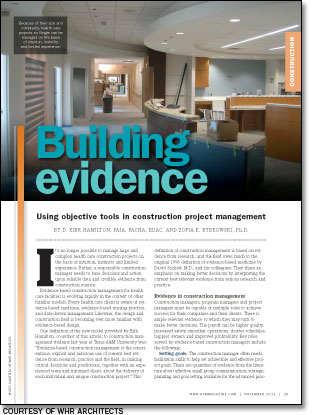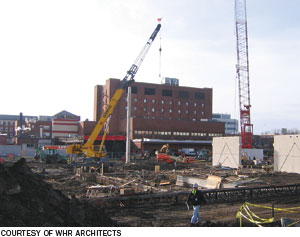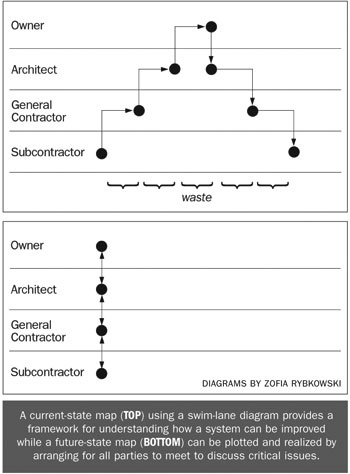 It's no longer possible to manage large and complex health care construction projects on the basis of intuition, instincts and limited experience. Rather, a responsible construction manager needs to base decisions and action upon reliable data and credible evidence from construction science.
It's no longer possible to manage large and complex health care construction projects on the basis of intuition, instincts and limited experience. Rather, a responsible construction manager needs to base decisions and action upon reliable data and credible evidence from construction science.
Evidence-based construction management for health care facilities is evolving rapidly in the context of other familiar models. Every health care client is aware of evidence-based medicine, evidence-based nursing practice, and data-driven management. Likewise, the design and construction field is becoming ever more familiar with evidence-based design.
One definition of the new model provided by Kirk Hamilton, co-author of this article, to construction management students last year at Texas A&M University was: "Evidence-based construction management is the conscientious, explicit and judicious use of current best evidence from research, practice and the field, in making critical decisions and predictions, together with an experienced team and informed client, about the delivery of each individual and unique construction project." This definition of construction management is based on evidence from research, and the field owes much to the original 1996 definition of evidence-based medicine by David Sackett, M.D., and his colleagues. They share an emphasis on making better decisions by interpreting the current best relevant evidence from serious research and practice.
Evidence in construction management
Construction managers, program managers and project managers must be capable of multiple roles to achieve success for their companies and their clients. There is ample relevant evidence to which they may turn to make better decisions. The payoff can be higher quality, increased safety, smoother operations, shorter schedules, happier owners and improved profitability. Key roles served by evidence-based construction managers include the following:
Setting goals. The construction manager often needs facilitation skills to help set achievable and effective project goals. There are quantities of evidence from the literature about effective small group communication, strategic planning and goal setting available for the advanced practitioner. There also is a body of literature associated with consensus building.
Estimating. A construction manager needs to master quantity survey estimating and be prepared to manage ongoing estimates of the project cost as adjustments and changes are made in the scope, design or material pricing. There also is a need to understand interactive spreadsheets capable of testing alternatives. Even a general contractor that relies on subcontractors for bids often runs its own estimate as a check against the bid prices it receives. Today's top performers will know how to manage a target-value costing model in collaboration with the owner and design team.
Administering the contract. Understanding contracts, the body of construction law and managing the interactions between parties is crucial to success for a construction manager. There is much to be learned about law, negotiation, arbitration and dispute resolution. Contract administration is very different when a project is delivered using design-bid-build, design-build or integrated project delivery.
Controlling the budget. Monitoring and controlling the budget is a primary function for the competent construction manager, and there is a growing body of practice theory and sophisticated software applications. Earned value analysis enables a manager to pinpoint whether a variance is because of either budgeting or scheduling problems.
Project scheduling. Managing the project schedule is another key role. Not all activities are equal in importance; a construction manager differentiates activities positioned along the critical path from those with float. The schedule needs to be continuously updated and these changes communicated to subcontractors on a regular basis. Regular communication of schedule changes to the rest of the stakeholders is critical to avoid work disruption and to achieve overall efficiency.
Managing construction operations. Construction operations involve managing the actual work on-site. The goal of a superintendent is to maximize productivity on-site. Examples include securing an efficient job site layout, avoiding crowded work spaces, ensuring that activities are coordinated, guaranteeing that proper tools are available when needed, and insisting that the workforce is properly trained and the quality of its output is supervised.
Dealing with change. Managing deviations from the work plan and effectively handling unexpected situations is a measure of maturity and experience. Cost overruns may be the result of owner-directed change orders, but they also may result from poor project management. Project managers need to know which activities are worth spending more to "crash" or compress in the schedule and which are not. They also need to know at which point over-compression leads to decreased efficiency.
Managing project quality. Managing project quality also is a responsibility of the construction manager. This means to meet or exceed demands specified in the design documents. Three quality objectives include "do things right the first time," "prevent things from going wrong" and "continually improve the process." Quality assurance involves making sure a system is in place at a company to support consistently high-quality work over time, while quality control involves ensuring that the work conforms to the plans and specs on a particular project.
Overseeing safety. Dealing with safety issues and risk management is another important role. It is said that all accidents are preventable and the construction manager has a vital role in creating a safe work environment. Knowledge and enforcement of Occupational Safety and Health Administration and Environmental Protection Agency requirements as well as the interim life safety measures, are crucial to successful project delivery. A strong safety record makes a contracting team more competitive at bid time.
Communicating. Communicating effectively with a complex team is how it all hangs together. There is much available in the way of specialized training for interpersonal communication and facilitation skills based on the evolving knowledge base. The explosion of communication technologies and social media profoundly is changing the way managers interact with the team.
Gathering evidence
It is important for any professional to develop a working ability with the pre-existing tools of any field. However, defining a knowledge base only by that which can be measured with pre-existing tools limits what can be known and improved. What if the construction manager also were encouraged to think in terms of the information he or she would need to manage the project more effectively?
When encouraged to follow an evidence-based construction management approach, a project manager might ask a different set of questions.

|
| Managing the actual work on-site includes securing an efficient job site layout, avoiding crowded work spaces, ensuring that activities are coordinated and guaranteeing that proper tools are available, among other things. |
A traditional, "seat-of-the-pants" way might be: "Sure, RFIs (Requests for Information) are taking a long time to process. But we are going to run this project the way I think it should be run because I am in charge, and this is the way I have always run jobs." However, an evidence-based way might be: "We seem to be spending a lot of time responding to and waiting for responses from RFIs. How might we reduce this time? I am going to take action and ask such measurement-seeking questions as, 'How might I calculate the amount of time that is being spent on answering RFIs?' I will search the literature to identify what others have done to collect data about this and improve the RFI situation. I will also brainstorm with my team, including our subcontractors, about ways to reduce the need to generate RFIs, propose and try a new approach, collect data and then, with my team, analyze the results. Once results are collected, I might ask, 'Does the new method improve the project?' If it does improve the new project, how might we standardize this so the lessons we learned from this project are passed on to future project managers?"
Evidence-based construction management isn't a brand new idea, of course. But the concept is "abuzz" more today than ever before. The construction management community has been looking to the fields of industrial engineering and management for ways to improve the construction industry. Project improvement areas such as Lean construction, the 5Ss and Six Sigma harness the power of gathering and analyzing evidence to help construction managers make smarter decisions.
Thanks to these movements, new evidence-gathering tools, such as swim-lane diagrams, fishbone diagrams, root cause analysis and the "last planner system", have entered the field of construction management. Evidence-based construction management has the potential to combine and synthesize the spirit these innovative movements share.
For example, one way to reduce RFI processing time is to create a current-state map with processing sequences on a swim-lane diagram and then to plot processing dates for each handoff of a project's RFI. A current-state map provides a framework for understanding how a system can be improved and reveals how much actual time is being wasted, while an RFI is sitting in a party's in-tray before being answered. A future-state map can be plotted and realized by arranging for all parties to meet face to face to discuss critical issues.
Changing the culture
Developing a culture of reliance on evidence for decision-making increases rigor in practice. Project managers must recognize that an evidence-based culture is also a respectful culture.
Good ideas come from many places — and especially often from those who are actually doing the work. An evidence-based culture acknowledges that decisions made using reliable evidence are generally more trustworthy than those based solely on subjective feelings.
Because of this, an evidence-based culture supports a meritocracy, where the caliber of a proposed solution is measured more by its truth value than by the rank of the individual proposing it. A wise and confident evidence-based construction manager knows this, and rather than being threatened by evidence, recognizes its value and supports those who wish to help gather it.
 How can one know that improvement is taking place? In the world of the evidence-based Lean construction movement, progress is made as project delivery approaches a state of flow.
How can one know that improvement is taking place? In the world of the evidence-based Lean construction movement, progress is made as project delivery approaches a state of flow.
Lean construction practitioners see variability as a key contributor to waste because variability creates problems for downstream stakeholders who rely on upstream stakeholders to complete their work properly and on time. A large number of change orders and RFIs, for example, are strong indicators that important decisions were inappropriately deferred or that instructions were not clear in the contract documents.
Change orders and RFIs delay a project. Unreliable stakeholders do as well. Lean construction's last planner system, for example, increases reliability by regularly measuring, graphing and then posting a running metric called percent planned complete for the project. The act of bringing together all stakeholders in the same room, asking each to declare his or her deliverables for next week's meeting, and then charting the percentage of declared items accomplished by that week increases the reliability of completion. The cumulative impact of increased reliability of deliverables is overall lower cost, shorter durations and higher quality than comparable projects.
There is a need for consistent, accurate recording of meaningful measures. "What do you wish to improve?" This question likely will tell construction managers what they need to observe and measure.
Finding objective rigor
Without an evidence-based approach to construction management, opinions can be subjective and every project remains hostage to the level of experience and judgment of the construction manager who happens to be assigned to the job.
By contrast, an evidence-based approach to construction management offers a level of objective rigor that is not solely dependent on the level of experience of the individual involved. In some respects, a less-entrenched manager may outperform an experienced one, because he or she may be more open to innovation — guided by the aid of evidence.
D. Kirk Hamilton, FAIA, FACHA, EDAC, is professor of architecture at Texas A&M University, College Station, and Zofia K. Rybkowski, Ph.D., is assistant professor in the college of architecture's department of construction sciences. They can be reached at khamilton@tamu.edu and zrybkowski@gmail.com, respectively.
| Sidebar - Scientific management principles + the search for evidence |
| Evidence-based management is an offspring of scientific management principles proposed early during the last century. In his 1911 book, The Principles of Scientific Management, Frederick Winslow Taylor observed that the then-prevailing "rule of thumb" form of management led to animosity and bitterness between the workers and the staff who managed them. He theorized, "The greatest obstacle to harmonious cooperation between the workmen and the management lay in the ignorance of the management as to what constitutes a proper day's work for a workman." He opined that workers felt this ignorance came from a lack of respect for them as individuals. As a result, they conspired as a group to underperform. Taylor had the opportunity to experience worker resentment firsthand by serving as a laborer and then a foreman early in his career. He recognized that not all individuals are equally suited for all forms of work. Taylor advocated observing and timing groups of workers and selecting those that excelled at particular tasks. For example, he observed that a superior pig iron handler could lift almost 300 percent more weight per day than an average laborer. He called these high-performing individuals "high-priced men" or "first-class laborers" and then recommended offering them individual incentives by increasing their pay by as much as 60 percent (a formidable improvement at the time). Taylor also ran experiments to determine the optimal percentage and spacing of rest periods to ensure that an individual could perform optimally. Those who could not perform adequately in a task should be routed to roles that are more appropriate to their talents and skills. According to Taylor, respect for individual talents and skills leads to greater collaboration between managers and laborers. One of Taylor's contemporaries, Frank B. Gilbreth, also began experimenting with improved work methods at about the same time. Unable to afford tuition at the Massachusetts Institute of Technology, Gilbreth apprenticed himself as a bricklayer. By the age of 27, he made his fortune by developing a scaffolding that reduced the time and effort needed by bricklayers to stoop and pick up bricks. He reduced the process of bricklaying from 18 motions per brick to five (one motion is called a Therblig — "Gilbreth" spelled backward). In another instance, Gilbreth wrote about the critical need for a manager to understand why a worker may have stopped working. Gilbreth said the worker may be loafing, waiting for materials that have run out, or be so efficient that he completed his work before others. The adversarial relationship that exists between traditional managers and workers predisposes the manager to assume a worker is loafing — and to automatically reprimand him. A scientific manager, by contrast, first will seek to understand the reason behind stopped work. If the worker is loafing, he should, indeed, be reprimanded. But if the stoppage is due to material shortage, he should be provided with the necessary materials. And if the worker is very fast, he should be praised rather than reprimanded and his methods studied by management so they can be replicated by others. — By Zofia K. Rybkowski |
| Sidebar - The last planner system + controlling production |
| One of the most successful recent inventions in construction management systems uses evidence to improve project planning. The last planner system (LPS) of production control was outlined and detailed in a 2000 doctoral thesis by Glenn Ballard, Ph.D., who later became co-founder of the Lean Construction Institute and Research Director of the Project Production Systems Laboratory at the University of California, Berkeley. Ballard's thesis emerged from an observation that reliability among stakeholders in construction rarely exceeds 70 percent. Such a reliability rate may sound reasonable enough, but it is problematically low in an industry where subcontractors depend on the reliable completion time of those who go before them to successfully complete their own work. For example, a drywall subcontractor cannot close a wall until the electrical contractor has finished installing electrical conduits. If the electrical subcontractor task completion is delayed even a few days, the drywall contractor may not be able to begin until a week or two later because it may have already committed its workforce and resources to other construction projects. Ballard recognizes the impact of performer reliability on the timely completion of a project and addresses the problem by tapping into basic principles outlined by pioneers Frederick Taylor, Frank Gilbreth, W. Edwards Deming and Taiichi Ohno. These pioneers have advocated the importance of respecting individual worker know-how. In traditional project management, the project manager creates the project schedule, deciding the duration of individual tasks, whether or not he or she has the appropriate experience or insight to do so. By contrast, in LPS, those who perform the work are actively involved in helping to plan the work, and are engaged in the process early on by being asked to identify precedents and constraints and to assign task durations using "stickies on a wall." A "pull" schedule of milestones is constructed backward from the client's required completion date. Removal of task constraints is discussed and applied weeks before the task is to be performed. When the week of activity performance arrives, subcontractors are asked to declare what they intend to accomplish each day of the week. Subcontractors then are held individually accountable for timely completion of the work they claimed would be finished. This measure, called percent planned complete (PPC), is posted and discussed among stakeholders, and has the effect of making subcontractor commitments more reliable. Those who have applied LPS claim that this simple act of collecting PPC can significantly improve a project's completion time and enhance the reliability that it will be finished by the time an owner requires, as exemplified by one of the case study projects from Ballard's thesis. To understand the relationship between variability and time, Iris Tommelein, Ph.D., also at the University of California, Berkeley, investigated the importance of trade dependency via roll of a die, and demonstrated the impact that activity time variability can have on an overall project's completion date. Results from Tommelein's research help health facility construction professionals see how the overall completion time for a project is extended when the completion times of individual activities vary. — By Zofia K. Rybkowski |




